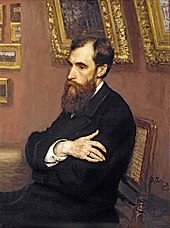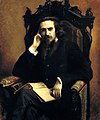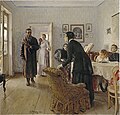Tretyakov Gallery
The State Tretyakov Gallery ( Russian Госуда́рственная Третьяко́вская галере́я , transcription Gossudarstwennaja Tretyakovskaya Galereja ) is an art museum in Moscow . With around 140,000 works of painting , graphics and sculpture , it is one of the largest and most famous art collections in Russia, alongside the Hermitage in St. Petersburg . These works cover the period from the 11th to the 20th century. The main building of the gallery is located on Lavruzhinsky Street in the historic Samoskvorechye district , near the Tretyakovskaya metro station .
history
It is named after its founder, the Russian textile merchant and art collector Pawel Michailowitsch Tretyakov (1832–1898). The beginnings of his art collection go back to 1851, when Tretyakov and his younger brother Sergei bought a two-story house south of the right bank of the Moscow River . The brothers set up their business premises on the ground floor of the building, while a considerable collection of paintings by local contemporary artists gradually emerged on the upper floor. Over the years, the collection grew so large that Pavel Tretyakov bought a piece of land in the immediate vicinity of the house in 1874 and had a new building built there to store the works. At the beginning of the 1890s, the collection already comprised around 1,500 items, including not only paintings, but also icons and sculptures.

When Sergei Tretyakov died in August 1892, he left a will, according to which he bequeathed his part of the art collection of the city of Moscow. A few weeks later, Pavel Tretyakov also donated the rest of the city's collection to enable the establishment of an art museum open to the public. The entire collection given to the city at that time comprised 1,287 paintings, 518 drawings and nine sculptures by Russian artists, as well as 75 paintings and eight drawings by contemporary German and French painters. The newly established art museum opened its doors to the public in August 1893 under the name of Moscow City Art Gallery Pawel and Sergei Mikhailovich Tretyakov . In gratitude for the donation, Pawel Tretyakov received the title of honorary citizen from the city of Moscow .
After Pavel Tretyakov's death in December 1898, the museum was run by the City Duma , whose members included Russian artists such as Ilya Ostrouchow . From 1899 to 1906 the Tretyakov House, which was now used as a museum building, was extensively rebuilt and received its current facade cladding, in the design of which the painter Viktor Wasnezow played a key role. This facade is essentially based on the traditions of old Moscow architecture and is decorated in the upper part with a relief representation of Saint George , which can also be seen in a similar form on the Moscow city coat of arms.
A few months after the October Revolution , the gallery was nationalized in June 1918 by decree of the revolutionary leader Lenin and received its current name State Tretyakov Gallery . Since then, there have been regular changing exhibitions in the gallery. In the 1920s, collections from numerous other museums as well as parts of various private collections confiscated by the state were integrated into the Tretyakov Gallery. This led to a considerable increase in the museum holdings, so that the gallery building had to be expanded in the mid-1930s due to a lack of space. This was implemented according to designs by the renowned architect Alexei Shtusev , who designed an extension that was completed in 1936 and which was architecturally based on the main building.
From 1941 to 1951 Alexander Ivanovich Samoschkin was director of the Tretyakov Gallery. During the Great Patriotic War of 1941–1945 , large parts of the museum exposition were transferred to Novosibirsk before the impending invasion of the Wehrmacht , where they were temporarily housed in the then unfinished Opera House building. This measure also turned out to be the right one, because during the Battle of Moscow the museum complex was significantly damaged in air raids. Only after the final victory over Germany and the completion of the reconstruction work could the museum be fully operational again. The grand reopening of the gallery took place on May 17, 1945.
In 1977 the gallery received a significant part of George Costakis ' collection . From 1980 to 1992 Yuri Koroljow (1929–1992) was director of the gallery. During this time, the museum was extensively rebuilt and expanded in order to cope with the increasing number of visitors and to better accommodate the existing stock. In 1986, a modern art department was also opened, located in a new building on the Moskva River, directly opposite the main entrance to Gorky Park . The main building of the museum was closed to visitors from 1986 to 1995 for renovation. Since reopening in April 1995, the Tretyakov Gallery has presented its exposition in a total of 62 halls in the completely renovated buildings.
Due to the COVID-19 pandemic , the Tretyakov Gallery published for the first time in its history a full photo collection of its exhibitions on the Russian-language Internet portal " Yandex Kollekzii". The losses during the closing time amounted to 2.7 million euros.
Selfira Tregulowa has been the director of the Tretyakov Gallery since March 2015 . Her predecessor since July 2009 was Irina Lebedewa (* 1956).
Permanent exhibition

Today the holdings of the Tretyakov Gallery include around 140,000 exhibits, including around 15,000 paintings, 4,500 icons and sculptures each, and over 100,000 drawings, graphics and similar works of art. Most of the collection is housed in the main building of the gallery in Samoskvorechye , where you can find works of art from the 11th to the beginning of the 20th century. This collection includes works of almost all well-known Russian artists of this era. The art of the later 20th century can be seen in the Modern Art Department, which opened in 1986. The museum complex also includes the Vasnetsov House in the northern part of Moscow's old town and the Church of St. Nicholas, built at the end of the 17th century, near the main gallery building.
Works of art (selection)
painting
Ivan Kramskoi
Christ in the Desert (1872)
Leo Tolstoy , 1873
Ivan Shishkin , 1873
Ivan Shishkin , 1880
The unknown , 1883
Tsar Alexander III , 1886
Dostoevsky on his death bed, drawing, January 29, 1881
Ilya Repin
Ivan the Terrible , 1870–1873
Dmitri Ivanovich Mendeleev , 1885
Modest Mussorgsky , 1881
Icons
Our Lady of Yaroslavl from the 13th century
Andrei Rublev , Trinity Icon , around 1411
Vision of Eulogios , around 1565/96
Theophanes the Greek : Our Lady of the Don
Web links
- Official website of the Tretyakov Gallery (Russian / English)
- Icons from the Tretyakov Gallery Collection
- Tretyakov Gallery. History and picture gallery
- The Tretyakov Gallery in the Google Art Project
Individual evidence
- ↑ Третьяковка за три месяца простоя недополучит прибыль в размере € 2.7 млн. Retrieved July 16, 2020 .
- ↑ Museums must be visitor-friendly . In: “RUSSIA BEYOND THE HEADLINES”, March 3, 2015. Accessed September 28, 2016.
Coordinates: 55 ° 44 ′ 29 ″ N , 37 ° 37 ′ 13 ″ E


























